Team-BHP
(
https://www.team-bhp.com/forum/)
Most car buyers/owners are not commonly bothered by which pair of wheels drives the car, i.e. whether a car is FWD (front wheel drive) or RWD (rear wheel drive). However, they sit up and take notice as soon as a car is sold with a badge of 4WD or 4x4 or AWD (all wheel drive). To the mind of the average car buyer/owner, 4WD gives the car some sort of invincibility in tackling no-road situations - which is not really true in most cases!
Now, all of us are aware that a FWD/RWD transmission setup is quite straightforward - it has an engine, a gearbox (manual or auto) and a differential driving the wheels on one axle. But how does one get all the 4 wheels to turn? This thread would attempt to elaborate on the different types of four-wheel-drive systems available in a variety of cars around the world. I seek inputs from all members with knowledge of 4WD transmission technology - please pitch in!
4WD systems can be divided into 3 main types:
1. Part-time 4WD - e.g. M&M Scorpio etc. and Tata Safari 4WD systems.
2. Full-time 4WD - e.g. Suzuki Grand Vitara, Toyota Fortuner.
3. On-demand 4WD - Honda CR-V, Hyundai Tucson (and now, the Tata Aria).
Part-time 4WD refers to a vehicle with selectable 4x4 or 4x2 (running on tarmac roads is in 4x2 mode, while 4x4 is engaged manually in slippery conditions). The driver has to manually shift between 2WD and 4WD using either a lever or a switch. With certain part-time 4WD transmission systems, you can "shift on the fly" (switch between 2WD and 4WD while driving). Part-time 4WD provides better traction on slippery surfaces because the front and rear sets of wheels are locked together. Thus, this is the optimum choice for most off-road conditions.
Vehicles with part-time 4WD systems do not have a centre differential, and should not be driven on high-grip road surfaces when in 4WD mode. This results in something called "transmission wind-up", which translates in simple terms to spending a lot of money on repairs.
================================================== =
Full-time 4WD (or permanent 4WD) means the vehicle is constantly providing power to all four wheels, sometimes with power being shifted between the front and rear axles as needed. This provides maximum traction in both dry and slippery driving conditions and requires no action from the driver to activate it. This type of system compulsorily has a centre differential, and transmission wind-up does not happen.
However, full-time 4WD doesn't provide as much mobility off-road as part-time 4WD does, because the system is designed such that it allows a set of wheels (front or rear) to spin if they don't have traction. To overcome this, a "lockable centre differential" or "limited slip centre differential" is employed.
Both part-time and full-time 4WD systems usually employ a 2-speed transfer case, where a second set of gear ratios provide lower gearing (providing better ability to climb slopes and tackle difficult terrain).
================================================== ==
On-demand or automatic 4WD is a full-time system that lets the vehicle operate in 2WD (either front or rear) until the car's system judges that 4WD or AWD is needed. It then automatically routes power to all four wheels, varying the ratio between front and rear axles as necessary. Usually a slipping wheel activates the system, however, some of the more sophisticated systems use software that switches the system to 4WD or AWD during specific driving conditions -- BEFORE a wheel begins to slip.
On-demand 4WD vehicles are not recommended for serious off-road driving. Although all four wheels can be powered at all times if so required, neither can the driver lock a centre differential, nor is there a low-ratio set of gears available to take on those steep slopes.
Good techy discussion; I love this.
Now, on a Part time or Manual 4WD, would there be two differentials, one in the front & one in the rear?
How about automatic 4WD? I assume there would be a central differential, but, the software controls the power distribution right?
Just few days back i was talking to one cousin of mine who bought a chevy beat and he thought that the rear wheels power the vehicle. When i told front wheels are actually powered through engine, he was very much in a shock that how front wheels can turn and power at the same time lol. I was very much surprised that how ill informed people can be about something as simple as this.
Quote:
Originally Posted by aargee
(Post 2104410)
Good techy discussion; I love this.
|
I hope everyone enjoys this... We'll try to keep it as simple as possible (i.e. follow the KISS principle! :) )
Quote:
Originally Posted by aargee
(Post 2104410)
Now, on a Part time or Manual 4WD, would there be two differentials, one in the front & one in the rear?
|
Yes. A part-time 4WD system cannot be used in 4WD mode on twisty tarmac roads, just because its centre diff is not there. This is how a simplified part-time 4WD system would look like.
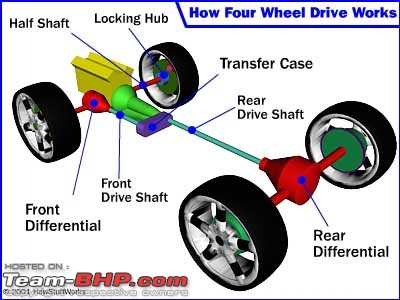
In a full-time 4WD system, the prerequisite is a centre diff. This is how it might look. (This one is apparently of a limited slip design.)
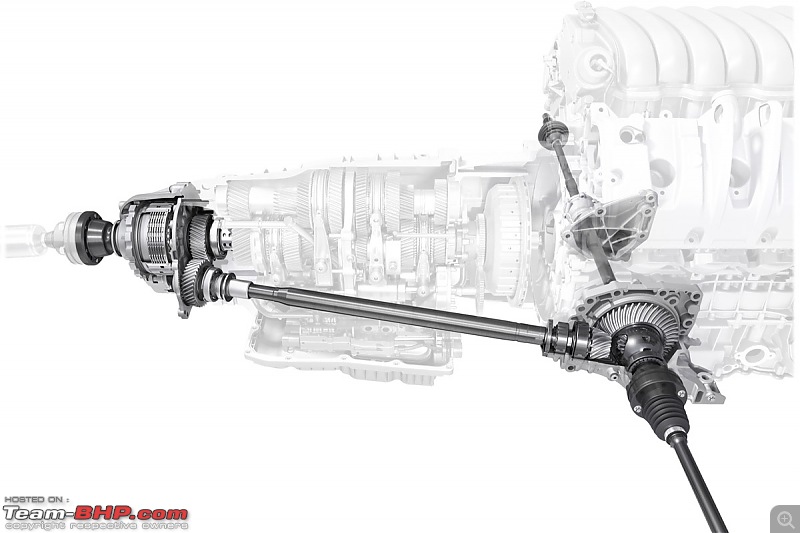
Quote:
Originally Posted by aargee
(Post 2104410)
How about automatic 4WD? I assume there would be a central differential, but, the software controls the power distribution right?
|
There are many methods by which the power is distributed to the front and rear in an automatic 4WD system. We'll look into some of them as we go along.
Quote:
Originally Posted by Rahulkool
(Post 2104416)
...he thought that the rear wheels power the vehicle.
|
Not that it matters to him either way! That is exactly what I mentioned right in the beginning:
Quote:
Most car buyers/owners are not commonly bothered by which pair of wheels drives the car...
|
hey SS really nice and very informative thread to begin with man. AWESOME!! :)
Team BHP has actually doubled my Auto-knowledge in the recent past but I was quite suprised a month back when I witnessed this:
I was awaiting my turn at the car wash while a Qualis was almost done with the wash. As there was a slight slope, the driver could not power the beast up in the second gear. So he downshifted and revved the car, the Rear Wheels just Spun with a screetch and the qualis just rushed out of the Pit!!
I had absolutely no clue that the Qualis was a RWD.
SS for my knowledge and many others around, could you please list out the various Cars, SUV's, MUV's available in India which Have either an AWD or RWD. I always thought that mostly the sports coupe's had RWD!!
Also, Why don't the manufacturer's in India provide any cars with a RWD when IMO I feel it might offer a better Grip.
Hi,
Great topic. Eagerly awaiting discussions on
A) dynamics of 4x4 systems
B) How torque is split.
Regards
Sutripta
Quote:
Originally Posted by Vik0728
(Post 2104465)
hey SS really nice and very informative thread to begin with man. AWESOME!! :)
...could you please list out the various Cars, SUV's, MUV's available in India which Have either an AWD or RWD.
|
Thanks, Vik. But that ought to be a topic for another thread!
Quote:
Originally Posted by Sutripta
(Post 2104495)
Great topic. Eagerly awaiting discussions on
A) dynamics of 4x4 systems
B) How torque is split.
|
Your inputs are required here!
Quote:
Originally Posted by SS-Traveller
(Post 2104453)
A part-time 4WD system cannot be used in 4WD mode on twisty tarmac roads...
|
In normal driving conditions, just one axle (the rear axle normally) is driven. In slippery conditions, another axle is engaged by the driver, whether by a lever or a switch. This type of all wheel drive does not have a centre differential - when all wheel drive is engaged, the front and rear driveshafts are mechanically connected and rotate at the same speed.
When a vehicle negotiates a turn, the front wheels travel greater distance than the rear wheels, as seen in the diagram below.
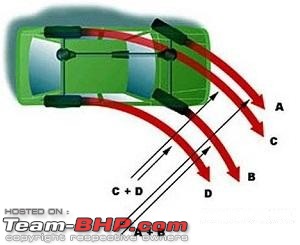
But there is no centre differential, so the front wheels cannot go faster than the rear wheels. Thus, turning on hard tarmac with all 4 wheels being driven, puts tremendous load on the gearbox & transfer case, which is also known as transmission windup. This increases the chances of the whole transmission system needing a very expensive replacement! Also, when all wheel drive is engaged, the vehicle heavily understeers; this can lead to an accident.
The 4-wheel-drive mode should only be used on surfaces with low traction (mud, sand, loose gravel, snow, ice), for short periods, and at low speeds. In these conditions the transmission windup is eliminated by slipping of the wheels.
Common cars on Indian roads using this system are the Gypsy, Scorpio and Safari 4x4 vehicles.
Edit: Copyright issues: Images in this thread are downloaded from the internet, and it is not always possible to acknowledge individual image owners/websites in each instance. Some images have watermarks showing copyright, though others don't. Some images may have additional information inserted for easier explanation. However, I would like to thank everyone for the images, which hopefully make the verbal explanations on this thread simpler to understand. In case there any reported copyright infringements, Moderators may kindly delete the related pictures.
Before we carry on about centre differentials et al., let us have a quick look at what a differential is supposed do, and how it works in simple terms. For that, we take a look at Wikipedia.
Quote:
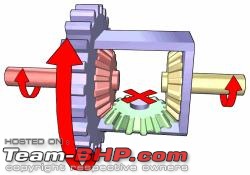
Input torque is applied to the ring gear (blue), which turns the entire carrier (blue), providing torque to both side gears (red and yellow), which in turn may drive the left and right wheels. If the resistance at both wheels is equal, the planet gear (green) does not rotate, and both wheels turn at the same rate.
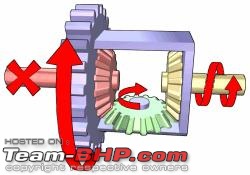
If the left side gear (red) encounters resistance, the planet gear (green) rotates about the left side gear, in turn applying extra rotation to the right side gear (yellow).
|
Quote:
Originally Posted by SS-Traveller
(Post 2104380)
Full-time 4WD (or permanent 4WD) means the vehicle is constantly providing power to all four wheels...
...a "lockable centre differential" or "limited slip centre differential" is employed.
|
So let's carry on in a little more detail about full-time 4WD...
The one place you see this system prominently displayed is in the picture below. The other Indian vehicle sporting this system (albeit without the tag on the rear) is the Grand Vitara.
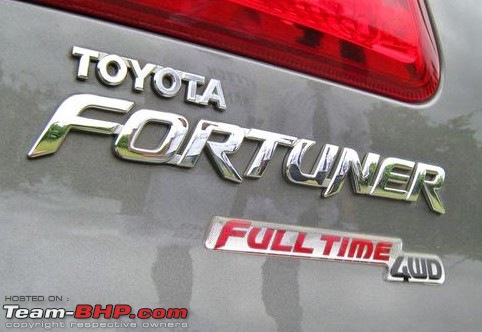
I'm fairly sure what GTO talked about in his post below, while reviewing the Fortuner, went a few metres above a lot of folks' heads. Does it make sense now?
Quote:
Originally Posted by GTO
(Post 1467341)
The Fortuner comes equipped with Full time 4x4, Torsen (torque sensing) limited slip differential and a dual ratio (high / low) transfer case. The diff is lockable too.
4x4 Drive Options:
Broadly, there are four options on the transfer box (smaller gear lever).
H : Default mode. Running in all time 4x4 with the center diff unlocked. This is what you will use 99% of the time. For tarmac use.
HL : 4x4 with center diff locked. 50:50 torque between the front & rear axles. Do NOT use this mode on tarmac (you will ruin the drivetrain). Best in slush, sand etc.
LL : 4x4, center diff locked, low ratio. Use in extreme offroad applications. Only crawling speeds possible.
N : Neutral. No drive provided to the front or rear wheels. Purpose is to serve as a bridge between High & Low ratio shifts.
|
Quote:
Originally Posted by SS-Traveller
(Post 2104512)
Your inputs are required here!
|
This is a topic meant for experts. As a not foolish (I hope) layman, do you think I should rush in!?
Quote:
Originally Posted by SS-Traveller
(Post 2104608)
I'm fairly sure what GTO talked about in his post below, while reviewing the Fortuner, went a few metres above a lot of folks' heads. Does it make sense now?
|
Actually GTOs post makes the Fortuners system seem like a normal 2 speed TC with a lockable central diff (when in H), and like our humble Jeeps when in L. I think its slightly more than that. An interesting discussion would be on why a Torsen needs a lock.
I think we are jumping in at the deep end. Lets start with the basics. Maybe the experts can answer a simpler question for us: -
If you were the vehicle designer, what would be your thought process which lead you to choose one of the drive configuration from all those (RWD, FWD, Full time 4x4, part time 4x4 .........., and options of LSDs and MLDs) available.
Regards
Sutripta
Quote:
Originally Posted by SS-Traveller
(Post 2104378)
. To the mind of the average car buyer/owner, 4WD gives the car some sort of invincibility in tackling no-road situations - which is not really true in most cases!
|
Hi SS_Traveller,
I would like you to elaborate on the above statement.
Part Time 4WD and Full-Time 4WD in comparison to a FWD or RWD are definitely invincible in
All no-road situations.
The Transfer Case has been under development as long as the automobile itself.
Regards,
Arka
Quote:
Originally Posted by Sutripta
(Post 2104749)
This is a topic meant for experts. As a not foolish (I hope) layman, do you think I should rush in!?
|
Must you be
SO modest?
Quote:
Originally Posted by Sutripta
(Post 2104749)
Actually GTOs post makes the Fortuners system seem like a normal 2 speed TC with a lockable central diff (when in H), and like our humble Jeeps when in L. I think its slightly more than that.
I think we are jumping in at the deep end. Lets start with the basics.
|
All right - let's make the Fortuner a case study.
First, it is a full-time 4WD - that automatically means THREE differentials instead of two - the two differentials for the front and rear axles, and a centre differential to keep it in 4WD mode all the time.
Quote:
Originally Posted by GTO
(Post 1467341)
The Fortuner comes equipped with Full time 4x4, Torsen (torque sensing) limited slip differential and a dual ratio (high / low) transfer case. The diff is lockable too.
|
So what on earth is a Torsen limited slip differential??? I'll talk about it in the next post.
Correct me if I am wrong, but it appears that in the India-specs Fortuner, only the centre differential is the Torsen-type diff - I believe Fortuners in other markets come equipped with both rear and centre diffs of the Torsen-type, which are lockable.
Quote:
Originally Posted by Sutripta
(Post 2104749)
Maybe the experts can answer a simpler questionfor us: -
If you were the vehicle designer, what would be your thought process which lead you to choose one of the drive configuration from all those (RWD, FWD, Full time 4x4, part time 4x4 .........., and options of LSDs and MLDs) available.
|
Let's have other folks pouring in their expertise too!
Quote:
Originally Posted by SS-Traveller
(Post 2104780)
So what on earth is a Torsen limited slip differential??? I'll talk about it in the next post.
|
Good luck. You are a braver man than I.
Ragards
Sutripta
| All times are GMT +5.5. The time now is 01:56. | |





